Raising Water Consciousness through
World’s Biggest Photo Exhibition and
Largest collection of Photo Stories on Water
Photo Stories | Drinking Water
Government Response to Urban Drinking Water Challenges
Nandita Singh and Om Prakash Singh
30 January, 2017
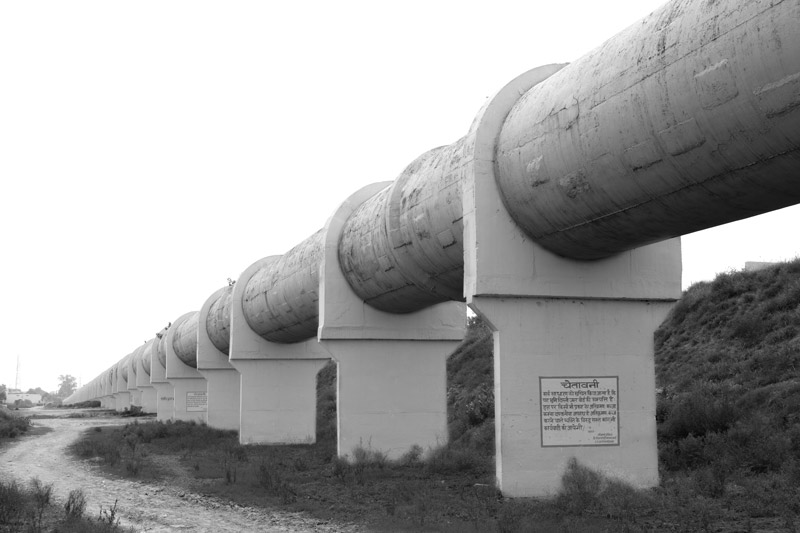
Urban drinking water challenges in India are multidimensional, spanning over quantity as well as quality issues. An overview of these challenges has been presented in the photo story titled “Urban Drinking Water Challenges” dated 15 January, 2017. These challenges undoubtedly thwart enjoyment of the human right to water by women, men and children residing in urban colonies and also hold negative implications for equitable and sustainable urban development in the country. Considering the gravity of these challenges, and recognizing its responsibility towards respecting, promoting and fulfilling the right as a signatory to the human right to water obligations, the government at national, state and local levels has initiated a number of interventions to address the challenges. In order to augment the shortfall of the demand versus the available supply, transfer of water from outside sources to urban centers has been initiated in some cities and groundwater resources have also been increasingly tapped. For fulfilling the water needs of the unauthorized colonies where laying of pipelines for individual household connections may present difficulty, tanker supply and public tapstands have been provided. Similarly, group connections have been provided at some other places. In hilly towns, interventions include construction of water storage tanks harnessing underground streams and springs. How adequate and effective have these government responses been in addressing the urban drinking water challenges in India? How well have these interventions helped promote the human right to water of the urban residents? This photo story presents critical reflections over the government responses initiated in some of the urban areas in India that face drinking water challenges, particularly from the urban residents’ perspectives. The title photo depicts the pipeline bringing Ganges water to the National Capital Territory of Delhi (NCTD) from the Upper Ganga Canal in Ghaziabad district, Uttar Pradesh. While addition of Ganges water has helped augment water supplies in some of the planned colonies in the NCTD, it has been critiqued as robbery of the human right to water of rural residents in Uttarakhand, besides leaving the water woes of the residents of the unauthorized colonies still unattended.
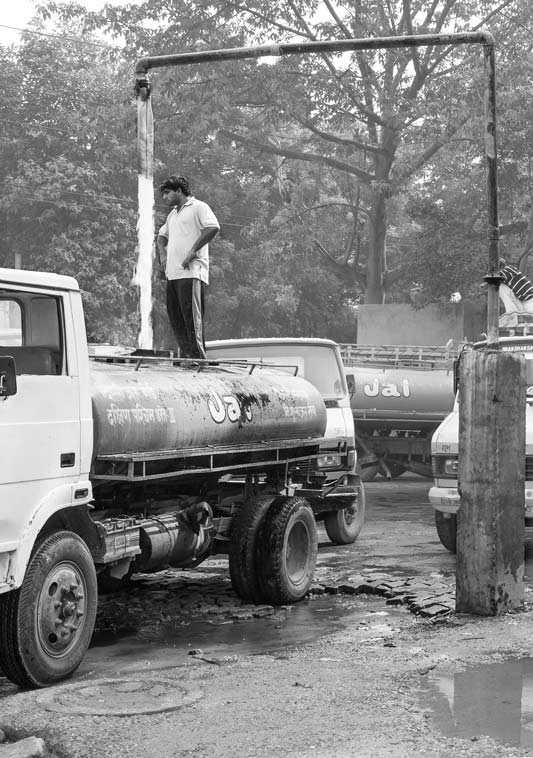
Tankers being filled to supply drinking water in informal colonies in South-West District, National Capital Territory of Delhi
According to Delhi Jal Board (DJB), the official agency responsible for water provision in the NCTD, there exist more than 1500 informal colonies, many of which are unserved by piped network. DJB shoulders the responsibility of supplying these colonies with drinking water through more than 800 tankers.
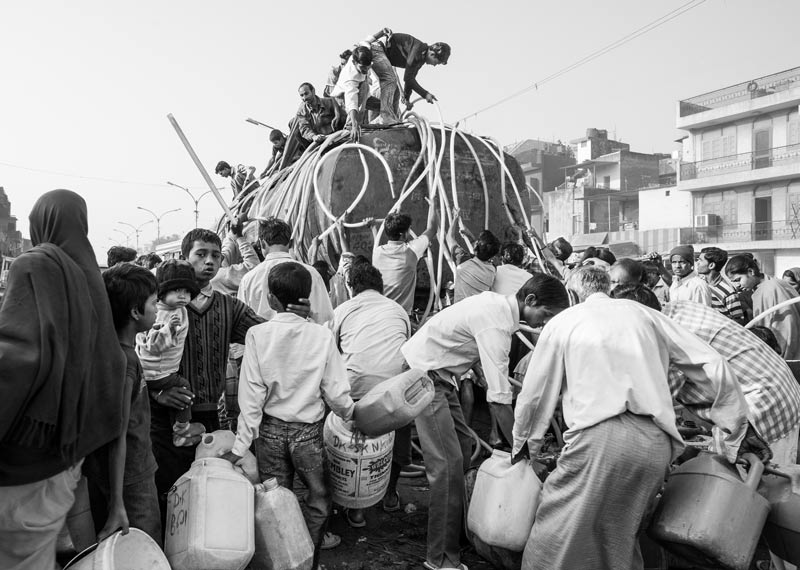
Women, men and children rushing to secure their share in the tanker water supply in South-East District, National Capital Territory of Delhi
The site of the water tanker brings a sigh of relief to the residents of the informal colonies served exclusively by them. However, according to the Comptroller and Auditor General (CAG) report (2013), about a quarter of the households in the city that are being supplied water through tankers in the absence of pipelines, have an average per capita supply of only 3.82 liters per day against the prescribed norm of 172 liters. This shows that tanker allocation versus the demand is grossly underestimated. This leads to great rush, struggle and even conflicts at the tanker venue and a tanker containing up to 9000 liters is siphoned off within minutes, with some even forced to return home empty-handed.
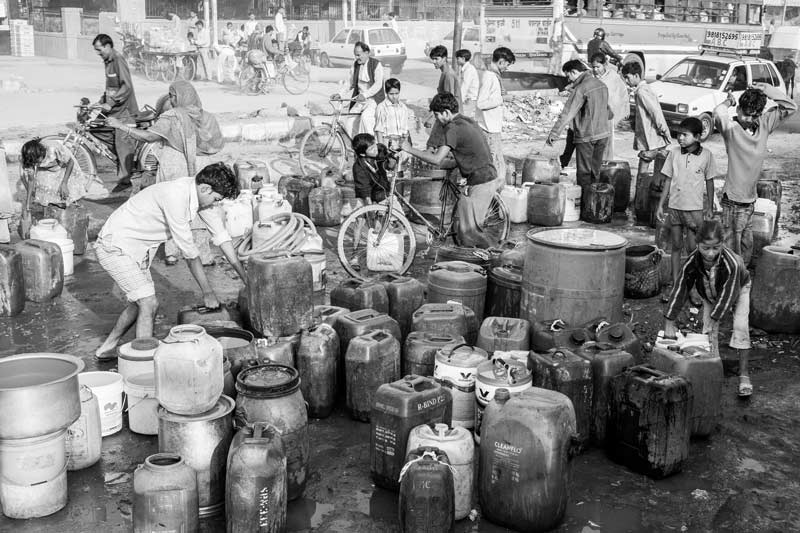
Traffic chaos and risk on a main road after departure of the water tanker in South-East District, National Capital Territory of Delhi
The DJB tankers deliver water at fixed and predetermined points in localities that have no piped water connection. While these points are claimed to be selected in consultation with local area representatives, these are often located along main roads with heavy traffic. As a result, while on the one hand, traffic congestion on the road may be a common scenario, the process of procuring the tanker water can itself become risky on the other, as boys and men who need to climb atop may have to rush amidst the traffic to secure their reach, and in the effort even risk slipping off. Even after an emptied tanker has departed, the traffic chaos generally continues until the filled-in containers are cleared, while the threat of accidents persists for those who attempt to collect their water containers amidst the moving cars and buses.
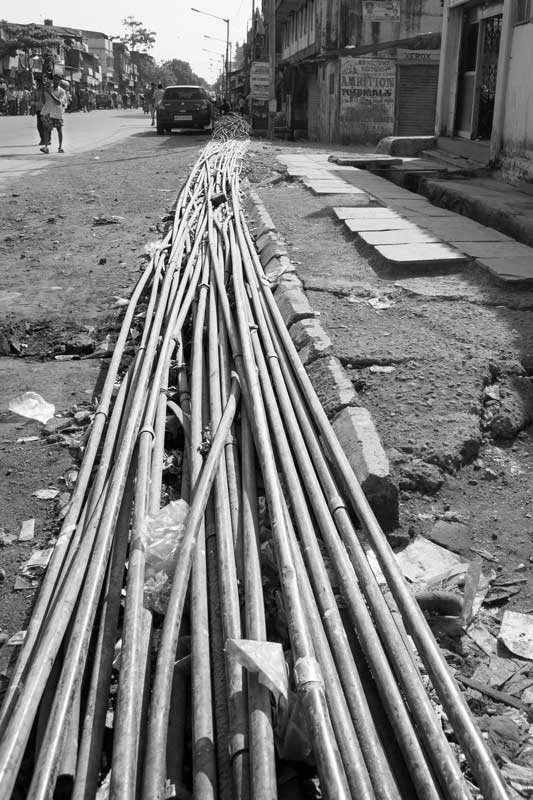
Pipes leading to group water connections in informal settlements in Mumbai, Maharashtra
In Mumbai's informal settlements the provision of securing water access through metered group water connections has been made by the Brihanmumbai Municipal Corporation (BMC). One group connection can be shared between 5-15 households, and is supposed to provide 45 liters per person per day (as opposed to 135 liters per person per day in residences in the 'formal' city). Earlier existing for only the pre-1995 slums/informal settlements, now the provision has been extended to all households located within such settlements under a new Mumbai High Court ruling in 2014 that seeks to ensure universal access to safe water as a fundamental human right protected under Article 21 of the Indian Constitution.
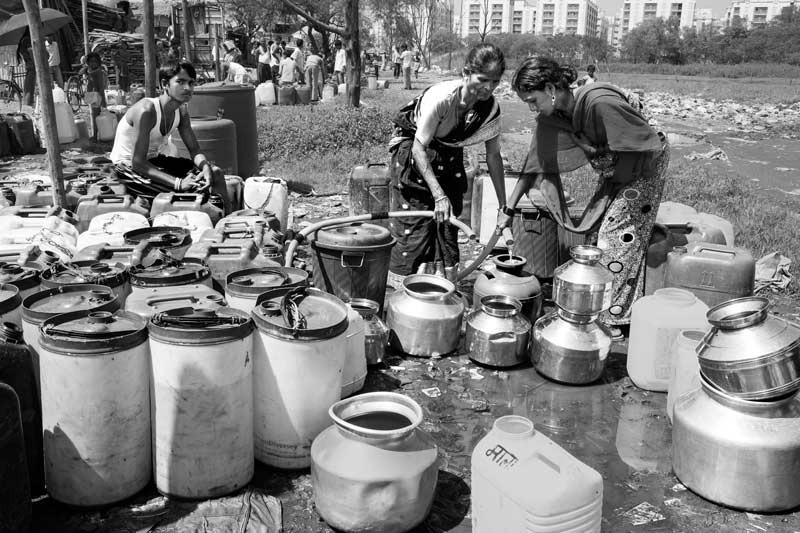
Struggling to fill long queues of containers with little water at low pressure at a group connection in Mumbai, Maharashtra
While the provision of group water connections for all households located within informal settlements is a welcome relief, these connections may not always materialize and when they do, they may not always address people’s hardships. The supply hours may be uncertain, making women, men and children wait for long, leaving aside other important chores. This may affect family incomes and hinder children’s education. Worst of all, sometimes even after the prolonged wait the taps may remain dry, thus making the entire effort a waste. At this group connection, the water supply is highly inadequate. One of the pipes is still dry though the expected supply timing is over, while the other one has too low a pressure which makes filling of the large number of containers placed in the long queue look like an impossible task.
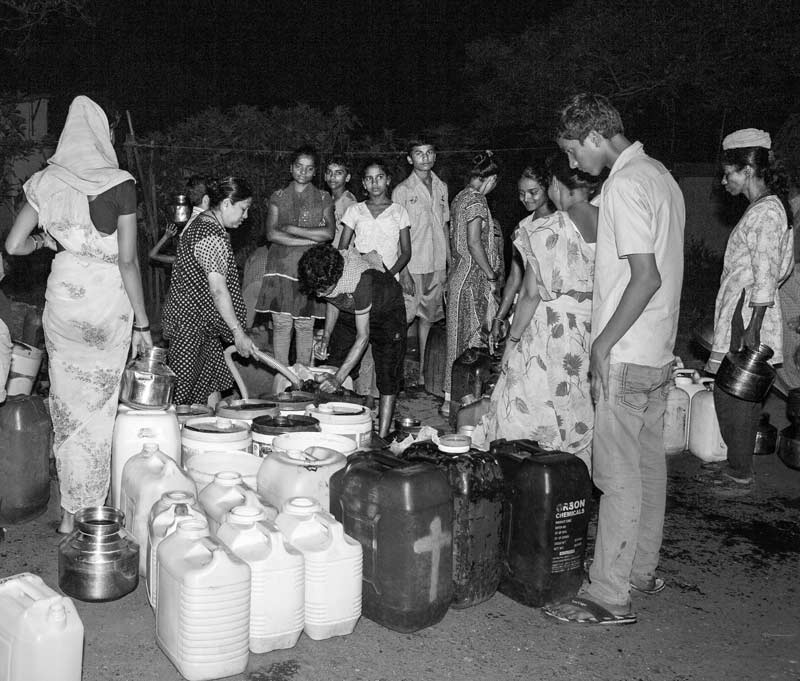
Women, men and children queuing to collect drinking water late in the night at a group connection in Mumbai, Maharashtra
In many cases, the water supply timings are odd, such as at this point where the expected timing is around 10 in the night. Since the supply duration is only one hour, all members of the household have to cooperate in quickly collecting the water, thereby disturbing sleep, hampering children’s studies and affecting other daily domestic chores.
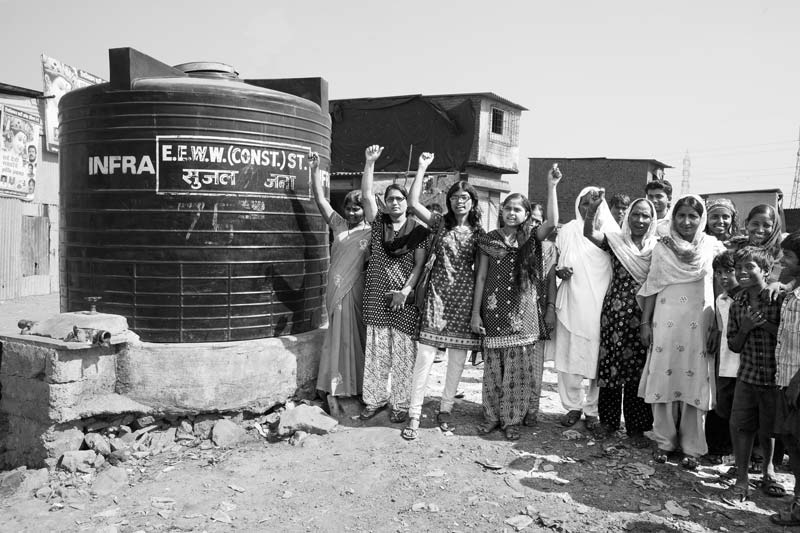
Women protesting to secure their human right to water near a government-installed water tank in an informal settlement in Mumbai, Maharashtra
Mumbai – the commercial capital of India –faces a large gap between water demand and supply. In an effort to improve the situation, the civic body BMC launched the ‘Sujal Mumbai Abhiyan’ in 2007 to ensure contamination-free potable water supply which improved the possibility of water access even in the hitherto unserved areas. The tank shown in this photo was installed as a public water source under this campaign, promising the women in this informal colony with improved access to water. However, the tank lacks a piped water connection, and is instead regularly filled by a tanker. Despite these arrangements, the women residents are still denied access to this public water source since some dominant individuals of the locality have authoritatively captured it, reserving the water for themselves or even making a personal profit by selling out the water. Despite these protests, no action has been taken by the authorities against the miscreants and water access has not been restored to the affected women.
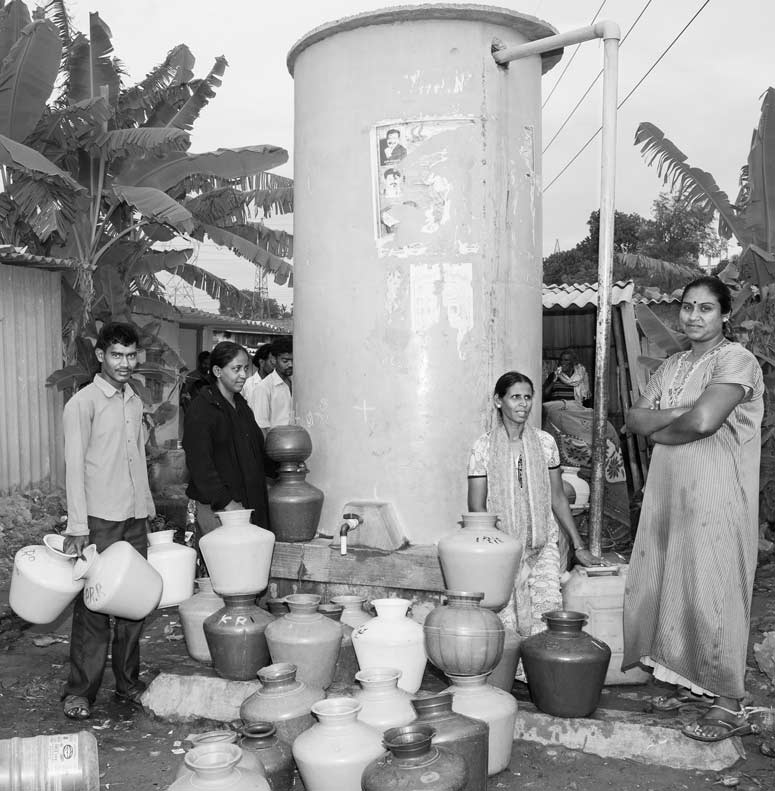
Women and men waiting for water at a public tapstand in an informal colony in Bengaluru, Karnataka
Bengaluru is one of the fastest growing metropolises in India, and up to 35% of the city’s population is estimated to be living in informal colonies or slums. Piped water supply within premises is almost absent in these colonies. However, in order to fulfil the human right to water of the residents, the municipal authority has installed multiple public tapstands supplied through borewells at convenient locations in these colonies. However, the water supply routines are uncertain and sometimes inconvenient. Also, the supply duration may be too short and the pressure low. At the tap stand shown in this photo, water is supposed to be supplied around 5 o’clock in the morning, but even around 6.15 water has not yet arrived.
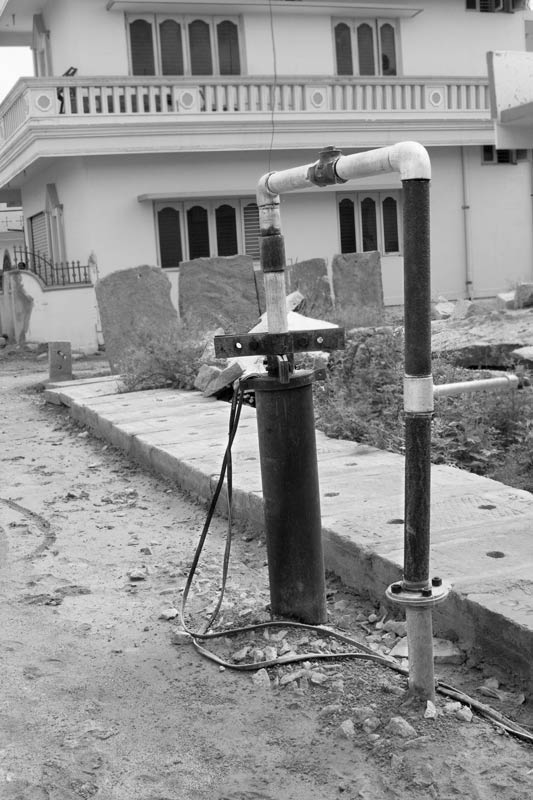
A tubewell for drinking water supply in Kolar city, Karnataka
In this newly planned colony in Kolar city, water supply for the residents has been provided by the government through tubewells. The tubewell shown here has been installed for supplying drinking water but the quality of the supplied water has not been monitored. The water is saline and also contains high fluoride levels, making it unsuitable for drinking. Consequently, while this tubewell water can be used by the residents only for washing, bathing, cleaning and other non-consumptive uses, but drinking water needs to be additionally purchased by them from alternate safe sources, mainly tankers, adding financial burden. Such instances are entered in official records as 'coverage' with drinking water supply, but in reality these amount to denial of the human right to water.
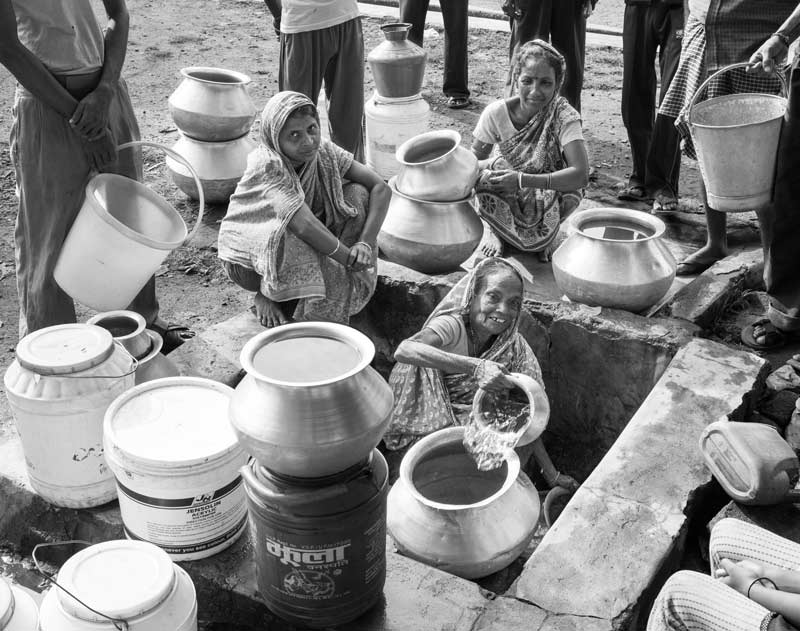
A public water supply point in Jharia Coal Fields, Dhanbad district, Jharkhand
Provision of drinking water is an important social responsibility shouldered by government undertakings in the mining sector. In Jharia Coal Fields, public tap stands have been provided for fulfilling the drinking water needs of the employees residing in colonies at the mining sites. However, while the tapstands exist, the water supply is inadequate, pressure is often low and the timing is uncertain and short, so that queue, rush and even conflicts may be common, and yet many families may eventually be unable to fill their containers.
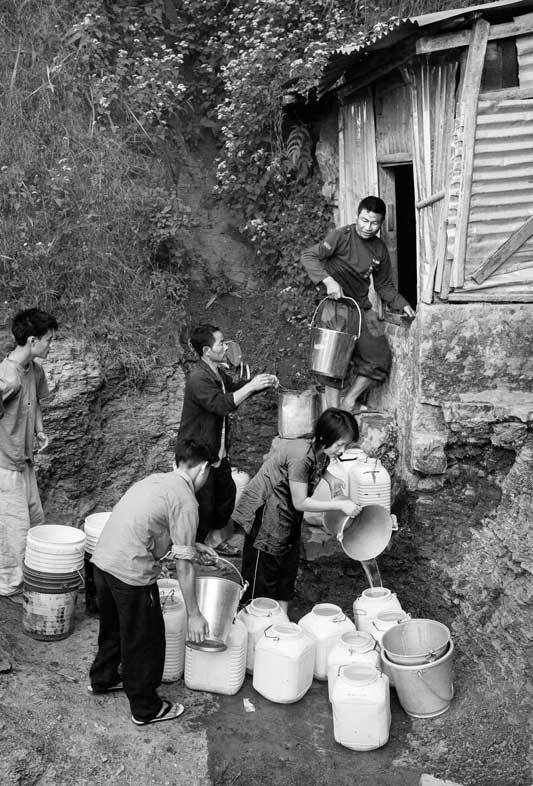
A water tank harnessing spring water for meeting the needs of urban residents in Mokokchung town, Nagaland
In urban centers in the hilly and mountainous regions, water availability after the monsoon season declines rapidly, and even piped networks fail to have adequate supply. In order to meet this challenge in Nagaland, one of the interventions of the government has been water tanks constructed at hill bases that are recharged by underground springs and streams. However, this effort is inadequate as the number of such tanks is few, the rate of recharge is slow, and this too declines rapidly as the dry season progresses, making people queue up for long for procuring limited water rations.
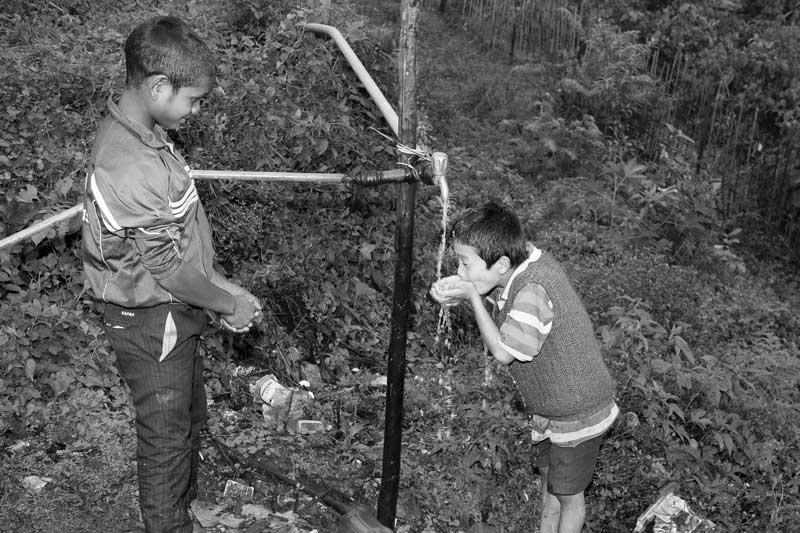
Piped drinking water supply at a school from a local stream in Garu town, Arunachal Pradesh
In Arunachal Pradesh, a hill state in North-Eastern India, the discharge in the streams and rivers is generally very high. This has been utilized by the government to facilitate urban populations with access to drinking water by directly piping the local stream waters. Such piped water supplies not only reach the urban residential colonies but are even extended to schools and other public facilities.
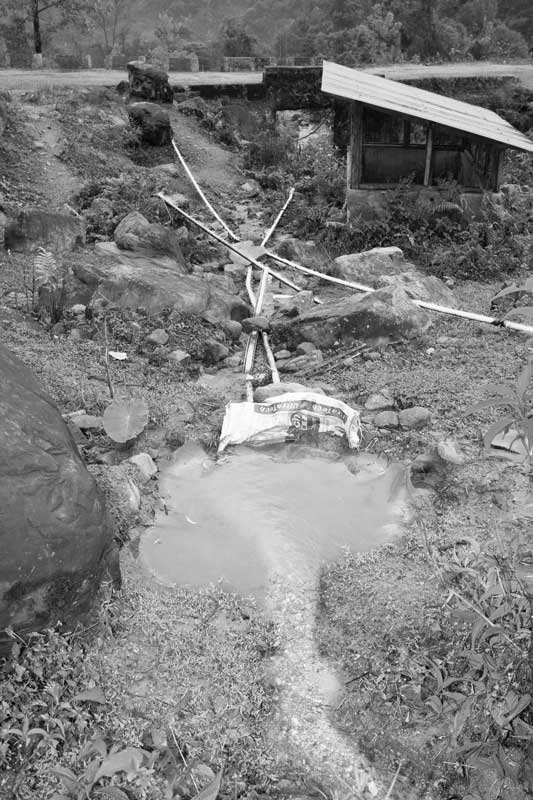
Piping water from an unprotected spring for supply in schools and other urban localities in Garu town, Arunachal Pradesh
Though the government's intervention of piping the stream waters helps improve coverage, a vital question that however arises is how safe is this supply water? This photo amply clarifies that the source of the piped water going to schools and houses is open and unprotected. This makes the water quality unsafe as it may contain sediments, worms, insects, microbes and other impurities from the surroundings. This water is directly supplied to the users without any treatment, leading to prevalence of water-borne diseases among schoolchildren and adults. This results in absenteeism from school because of illhealth, keeps adults away from work, and increases medical bills.
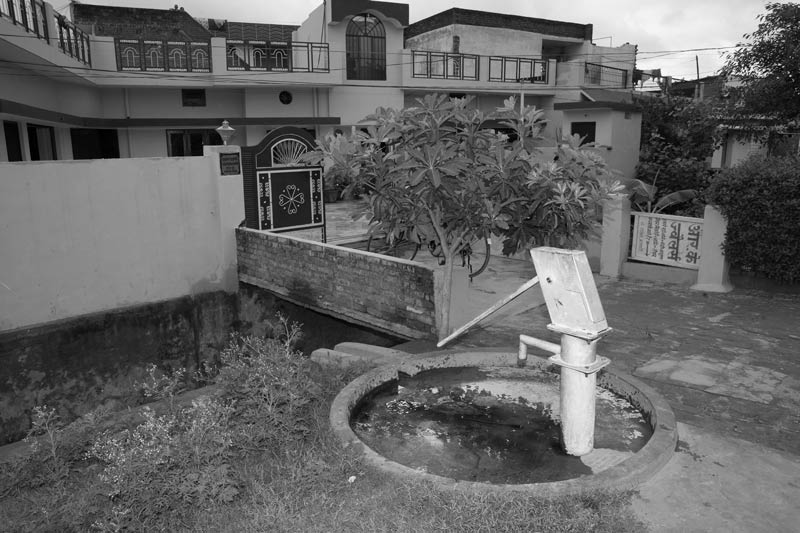
A ‘privatized’ public handpump in Izzat Nagar, Bareilly city, Uttar Pradesh
Public handpumps have been installed by the government in many urban areas that are unserved by piped water connections. Generally, these are targeted at the poorer urban segments who cannot afford to have individual handpumps installed. Despite the government norms, the ‘public’ handpump shown in this photo has been “individualized” by an affluent and influential family that has managed to get it installed in front of their private house and who alone enjoy access to its water. It is noteworthy that this affluent family already enjoys access to drinking water within their premises through a separate private tubewell. This signifies a waste of public resources and denial of human right to water to the real needy.
The different government interventions for addressing the urban water challenges through the decades have undoubtedly helped improve the residents’ access to drinking water, thereby promoting and fulfilling their human right to water. Since 1991, the coverage with access to improved drinking water sources has increased from 26% to 31%, notwithstanding the exponential growth of urban population. However, a lot more remains to be done. Most cities in India are already water stressed, and no city has 24/7 water supply. According to the national government, as many as 182 cities require immediate attention with regard to proper water management. As this photo story reveals, despite the multifarious government efforts, lack of equitable access to adequate and safe water continues to persist as the major challenge. While on the one hand, there is challenge of adequate urban water availability especially in a climate change regime, on the other hand, there are problems with the quality of water delivered. Besides, there also exist governance issues like responsibility, accountability, transparency and justice. There is need for government at all levels to work further on these challenges so that equitable access to safe water can be ensured for all urban women, men and children. Otherwise, human right to water of the ever-increasing urban Indian population will continue getting hampered, in turn leading to non-realization of their several other human rights including health, education, livelihood, culture and overall development. This in turn will also jeopardize equitable and sustainable urban development in the country.